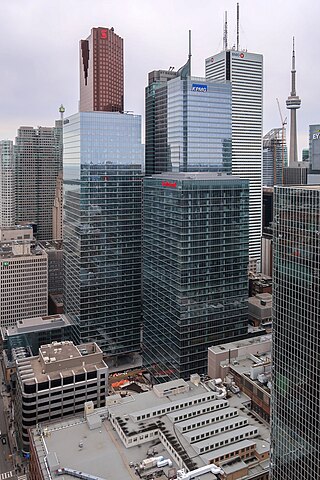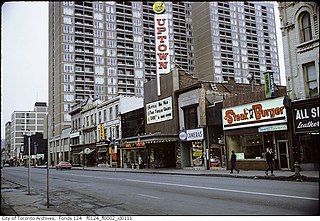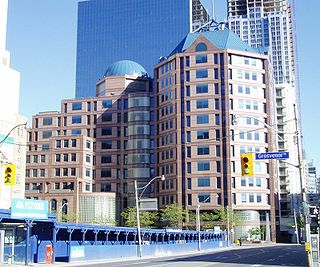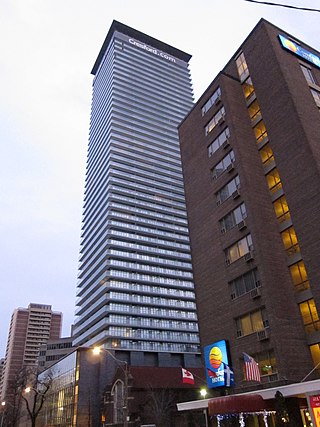
North Toronto is a former town and informal district located in Toronto, Ontario, Canada. The Town of North Toronto was incorporated in 1890 by consolidating the villages of Bedford Park, Eglinton and Davisville. The town was annexed by Toronto in 1912. The name is still used to refer to the area in general, although Yonge–Eglinton and Midtown Toronto are officially used.

Deer Park is a neighbourhood in Toronto, Ontario, Canada. It is centered on the intersection of Yonge Street and St. Clair Avenue and its boundaries are the Vale of Avoca section of Rosedale ravine in the east, Farnham Avenue and Jackes Avenue in the south, Avenue Road and Oriole Parkway in the west, the Beltline Trail in the north on the west side of Yonge Street, and Glen Elm Avenue in the north on the east side of Yonge Street. For the purposes of social policy analysis and research, the Toronto government’s Social Development & Administration division includes Deer Park within the City of Toronto's official "Rosedale-Moore Park" and "Yonge-St.Clair" neighbourhood profiles. The neighbourhood is in Ward 22, represented by Councillor Josh Matlow at Toronto City Council.

The Battle of Montgomery's Tavern was an engagement which took place on December 7, 1837 during the Upper Canada Rebellion. The abortive revolutionary insurrection, inspired by William Lyon Mackenzie, was crushed by British authorities and Canadian volunteer units near John Montgomery's tavern on Yonge Street at Eglinton, north of Toronto.

The Bay Adelaide Centre is an office complex in the Financial District of Toronto, Ontario, Canada. The first phase, a 51-storey skyscraper known as Bay Adelaide West, was completed in July 2009. The second phase, the 44-storey Bay Adelaide East, was completed in October 2016. A third tower, Scotiabank North Tower, opened in 2022 and serves the new global head office of Canadian bank Scotiabank.
Finch Hotel was an inn located in current-day Toronto, Ontario, Canada. It was opened in 1848 by John Finch on Lot # 2, Concession # 1, with a land size of 200 acres (81 ha). Before Finch's takeover, the inn was owned by Thomas Johnson from the late 1790s.

The Garden District is a neighbourhood in downtown Toronto, Ontario, Canada. The name was selected by the Toronto East Downtown Residents Association (TEDRA) in recognition of Allan Gardens, an indoor botanical garden located nearby at the intersection of Carlton and Jarvis Streets. The Garden District was officially designated by the Mayor and Toronto City Council in 2001, while TEDRA has since been renamed the Garden District Residents Association. Part of the neighbourhood is within official City of Toronto neighbourhood of Moss Park.

College Park is a shopping mall, residential and office complex on the southwest corner of Yonge and College streets in Toronto, Ontario, Canada.

One Yonge Street is a 25-storey office building in Toronto, Ontario, Canada. The building served as the headquarters of Torstar and its flagship newspaper, the Toronto Star, from 1971 to 2022. It is 100 metres tall and built in the International style. It was built as a replacement to the Old Toronto Star Building, which was located at 80 King Street West. That building was torn down to make room for First Canadian Place.

The Uptown Theatre was a historic movie theatre in Toronto, Ontario which was demolished in 2003. The entrance to the theatre was located on Yonge Street just south of Bloor. Like many theatres of the time it was constructed so that only the entrance was on a major thoroughfare while the main building fronted on a side street. A bridge connected the two buildings.

Toronto Police Headquarters is the headquarters of the Toronto Police Service, located at 40 College Street in Toronto, Ontario, Canada. It is the first purpose-built police headquarters in Toronto since the formation of the city's original police force in 1835.

The Minto Midtown is a residential complex on Yonge Street in Toronto in the Davisville neighbourhood near Yonge and Eglinton consisting of two towers, Quantum and Quantum 2 developed by Minto Developments Inc. The proposed project—which substantially exceeded existing height and zoning limits—was met with substantial neighborhood and city opposition, until Minto appealed to the Ontario Municipal Board and worked out a deal with the City of Toronto.

Aura is a mixed-use skyscraper completed in 2014 in Toronto, Ontario, Canada. It is the final phase of a series of condominium buildings near College Park in Toronto's Downtown Yonge district. It is part of the Residences of College Park project. Construction lasted from 2010 to 2014. With 80 floors, as of 2018 it is the tallest residential building in Canada and the 38th tallest residential building in the world.

Casa Condominio Residenza, or The CASA, is a high-rise condominium building at 33 Charles Street East near the intersection of Bloor Street and Yonge Street in downtown Toronto, Ontario, Canada. It features a New Modernist design by architectsAlliance emphasizing glass curtain wall, with balconies wrapped around the building from the podium to the top. An overhanging concrete slab concludes the design at the roof of the final floor. It is lit from underneath at night. The balconies themselves have transparent glazed balustrades, and the podium's main facade facing Charles Street also makes use of glass curtain wall extensively, framed with black brick.

Burano is a 50 storey, 163 metre tall residential high-rise condominium complex on Bay Street between Grenville St. and Grosvenor St. in the Discovery District of Downtown Toronto, Ontario, Canada. The redevelopment of the site was part of a period of urban renewal of the Toronto financial district in the early 21st century. Toronto City Planning stated that the Burano has "significantly contributed to the improvement of the streetscape and the public realm."

The Empress Hotel was a three-storey red-brick building at the corner of Yonge and Gould streets in downtown Toronto. It was destroyed by fire on January 3, 2011. The hotel was opened in 1888. The hotel changed hands several times. The property ceased operating as a hotel in the mid-1970s.

Colborne Street is a street running several hundred metres east of Yonge Street in downtown Toronto, Ontario, Canada. It crosses Victoria Street and Leader Lane, ending at Church Street. It is located between and parallel to King Street East and Wellington Street East. The street is notable for retaining several historic buildings built during the reign of Queen Victoria.

Massey Tower is a condo complex in Toronto, Ontario, Canada, spanning the block below Shuter Street, between Yonge and Victoria streets. The complex's northeast corner added much-needed backstage space to historic Massey Hall. To the south of the complex lies the historic Elgin and Winter Garden Theatres. The Yonge Street facade uses the 1905 Canadian Bank of Commerce headquarters at 197 Yonge Street, vacant since 1987. The complex's tower rises 60 storeys and stands 208.3 metres (683 ft) in height.

Sam Mizrahi is an Iranian-born Canadian real estate developer who is active in Toronto. Mizrahi is currently the president of a number of corporations, including Mizrahi Developments, Mizrahi Inc. and Mizrahi Enterprises Inc. He is best known for being the developer of The One skyscraper at the intersection of Yonge and Bloor streets in Toronto. In 2015, Toronto Life named him the 45th most influential person in Toronto.

The One is a supertall skyscraper currently under construction in Toronto, Ontario, Canada. If completed, it will be the tallest building in Canada. At a revised 306.3 metres and a revised 85 storeys, it will be taller than First Canadian Place, which has been Canada's tallest building since 1975. It will also be Canada's first supertall skyscraper, as defined by the Council on Tall Buildings and Urban Habitat. Construction of the building is estimated to be completed by March 2025.


















